简单句、并列句和复合句
- 格式:ppt
- 大小:55.50 KB
- 文档页数:24
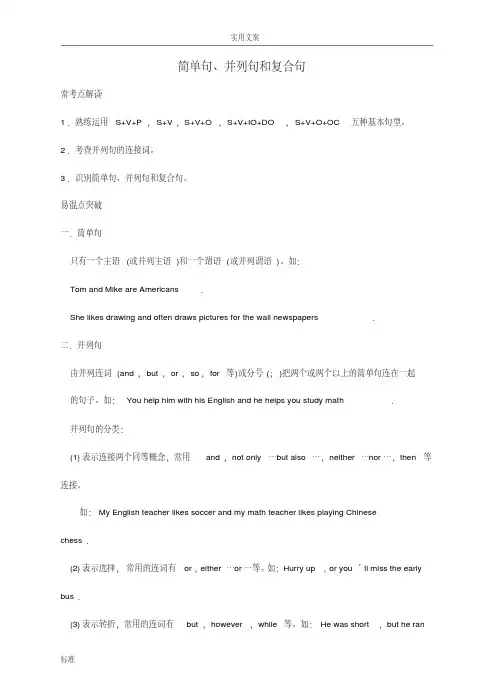
简单句、并列句和复合句常考点解读1.熟练运用S+V+P,S+V,S+V+O,S+V+IO+DO,S+V+O+OC五种基本句型。
2.考查并列句的连接词。
3.识别简单句、并列句和复合句。
易混点突破一.简单句只有一个主语(或并列主语)和一个谓语(或并列谓语)。
如:Tom and Mike are Americans.She likes drawing and often draws pictures for the wall newspapers.二.并列句由并列连词(and,but,or,so,for等)或分号(;)把两个或两个以上的简单句连在一起的句子。
如:You help him with his English and he helps you study math.并列句的分类:(1)表示连接两个同等概念,常用and,not only…but also…,neither…nor…,then等连接。
如:My English teacher likes soccer and my math teacher likes playing Chinesechess.(2)表示选择,常用的连词有or,either…or…等。
如:Hurry up,or you’ll miss the early bus.(3)表示转折,常用的连词有but,however,while等。
如:He was short,but he ranvery fast.(4)表示因果关系,常用的连词有so,for等。
如:He felt bad,so he didn’t go to schoolthis morning.三.复合句复合句指的是含有两个或更多的主谓结构的句子,其中有一个(或更多)主谓结构充当句子某一(些)成分,如主语、宾语、表语、定语、状语、同位语等,主语从句、宾语从句、表语从句、同位语从句、定语从句和状语从旬都属于复合句。
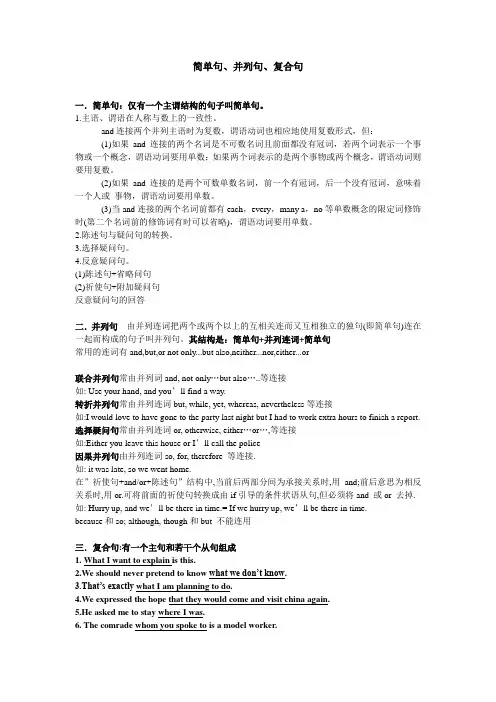
简单句、并列句、复合句一.简单句:仅有一个主谓结构的句子叫简单句。
1.主语、谓语在人称与数上的一致性。
and连接两个并列主语时为复数,谓语动词也相应地使用复数形式,但:(1)如果and连接的两个名词是不可数名词且前面都没有冠词,若两个词表示一个事物或一个概念,谓语动词要用单数;如果两个词表示的是两个事物或两个概念,谓语动词则要用复数。
(2)如果and连接的是两个可数单数名词,前一个有冠词,后一个没有冠词,意味着一个人或事物,谓语动词要用单数。
(3)当and连接的两个名词前都有each,every,many a,no等单数概念的限定词修饰时(第二个名词前的修饰词有时可以省略),谓语动词要用单数。
2.陈述句与疑问句的转换。
3.选择疑问句。
4.反意疑问句。
(1)陈述句+省略问句(2)祈使句+附加疑问句反意疑问句的回答二.并列句由并列连词把两个或两个以上的互相关连而又互相独立的独句(即简单句)连在一起而构成的句子叫并列句。
其结构是:简单句+并列连词+简单句常用的连词有and,but,or not only...but also,neither...nor,either...or联合并列句常由并列词and, not only…but also…..等连接如: Use your hand, and you’ll find a way.转折并列句常由并列连词but, while, yet, whereas, nevertheless等连接如:I would love to have gone to the party last night but I had to work extra hours to finish a report. 选择疑问句常由并列连词or, otherwise, either…or…,等连接如:Either you leave this house or I’ll call the police因果并列句由并列连词so, for, therefore 等连接.如: it was late, so we went home.在”祈使句+and/or+陈述句”结构中,当前后两部分间为承接关系时,用and;前后意思为相反关系时,用or.可将前面的祈使句转换成由if引导的条件状语从句,但必须将and 或or 去掉. 如: Hurry up, and we’ll be there in time.= If we hurry up, we’ll be there in time.because和so; although, though和but 不能连用三.复合句:有一个主句和若干个从句组成1. What I want to explain is this.2.We should never pretend to know what we don’t know.3.That’s exactly what I am planning to do.4.We expressed the hope that they would come and visit china again.5.He asked me to stay where I was.6. The comrade whom you spoke to is a model worker.。
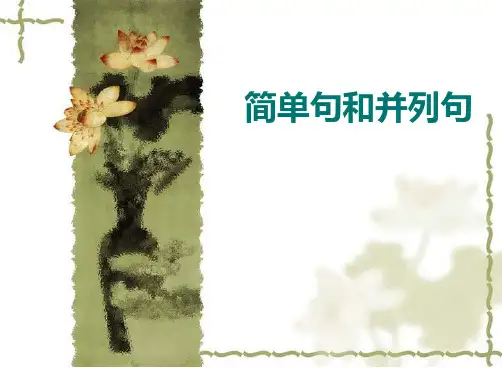
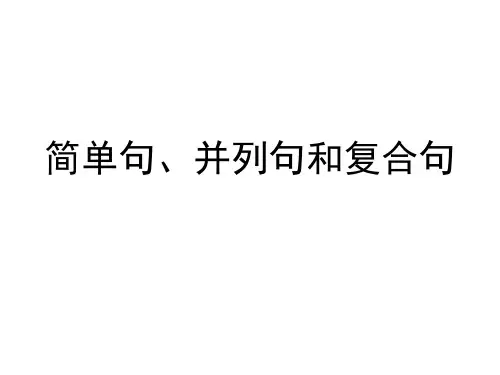
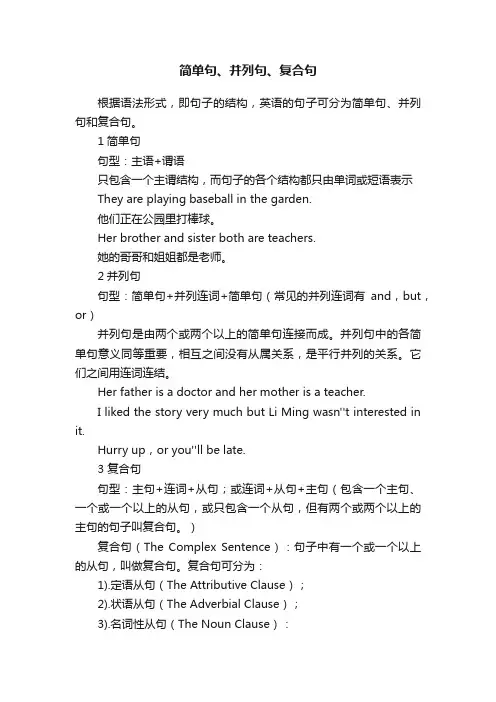
简单句、并列句、复合句根据语法形式,即句子的结构,英语的句子可分为简单句、并列句和复合句。
1简单句句型:主语+谓语只包含一个主谓结构,而句子的各个结构都只由单词或短语表示They are playing baseball in the garden.他们正在公园里打棒球。
Her brother and sister both are teachers.她的哥哥和姐姐都是老师。
2并列句句型:简单句+并列连词+简单句(常见的并列连词有and,but,or)并列句是由两个或两个以上的简单句连接而成。
并列句中的各简单句意义同等重要,相互之间没有从属关系,是平行并列的关系。
它们之间用连词连结。
Her father is a doctor and her mother is a teacher.I liked the story very much but Li Ming wasn''t interested in it.Hurry up,or you''ll be late.3 复合句句型:主句+连词+从句;或连词+从句+主句(包含一个主句、一个或一个以上的从句,或只包含一个从句,但有两个或两个以上的主句的句子叫复合句。
)复合句(The Complex Sentence):句子中有一个或一个以上的从句,叫做复合句。
复合句可分为:1).定语从句(The Attributive Clause);2).状语从句(The Adverbial Clause);3).名词性从句(The Noun Clause):一、定语从句定语从句的定义定语从句在句子中作定语,用来修饰一个名词、名词词组或者代词。
先行词和引导词被修饰的名词、名词词组或代词叫做先行词;在先行词和定语从句之间起连接作用的词叫做引导词。
引导词分为“关系代词”和“关系副词”。
关系代词和关系副词关系代词有:who, whom, whose, that, which, as。
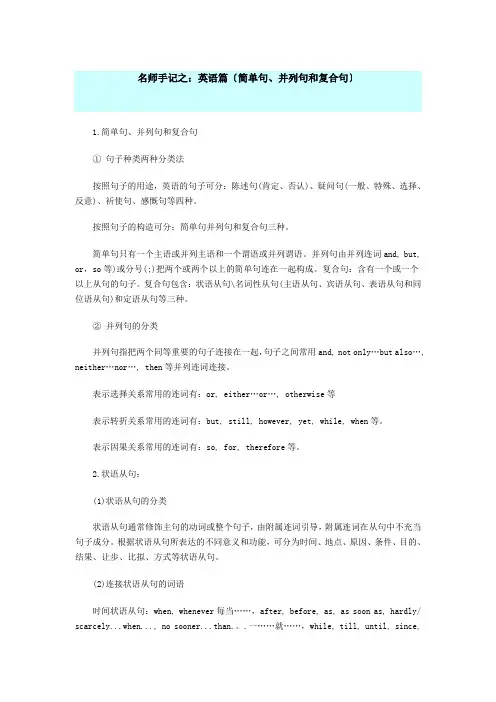
名师手记之:英语篇〔简单句、并列句和复合句〕1.简单句、并列句和复合句① 句子种类两种分类法按照句子的用途,英语的句子可分:陈述句(肯定、否认)、疑问句(一般、特殊、选择、反意)、祈使句、感慨句等四种。
按照句子的构造可分:简单句并列句和复合句三种。
简单句只有一个主语或并列主语和一个谓语或并列谓语。
并列句由并列连词and, but, or,so等)或分号(;)把两个或两个以上的简单句连在一起构成。
复合句:含有一个或一个以上从句的句子。
复合句包含:状语从句\名词性从句(主语从句、宾语从句、表语从句和同位语从句)和定语从句等三种。
② 并列句的分类并列句指把两个同等重要的句子连接在一起,句子之间常用and, not only…but also…, neither…nor…, then等并列连词连接。
表示选择关系常用的连词有:or, either…or…, otherwise等表示转折关系常用的连词有:but, still, however, yet, while, when等。
表示因果关系常用的连词有:so, for, therefore等。
2.状语从句:(1)状语从句的分类状语从句通常修饰主句的动词或整个句子,由附属连词引导,附属连词在从句中不充当句子成分。
根据状语从句所表达的不同意义和功能,可分为时间、地点、原因、条件、目的、结果、让步、比拟、方式等状语从句。
(2)连接状语从句的词语时间状语从句:when, whenever每当……,after, before, as, as soon as, hardly/ scarcely...when..., no sooner...than.。
.一……就……,while, till, until, since,once。
名词词组the first time第一次,last time最后一次,every/each time每次,the next time下次,the next day第二天, the moment, the minute, the second, the instant 一……就……;副词immediately, instantly, directly等也可作连词使用。
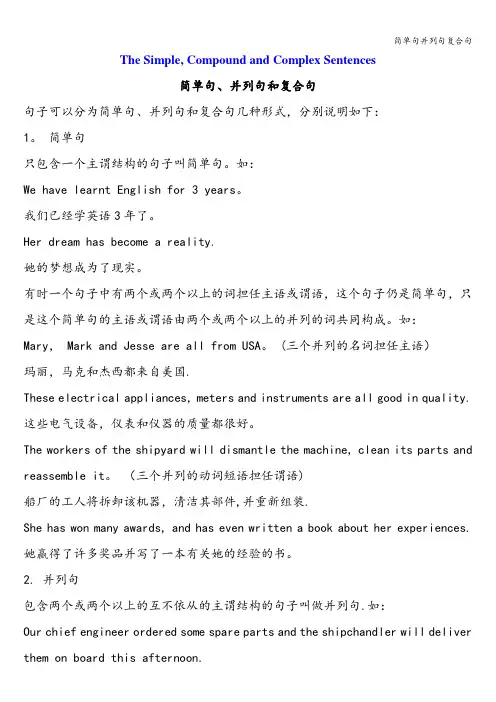
The Simple, Compound and Complex Sentences简单句、并列句和复合句句子可以分为简单句、并列句和复合句几种形式,分别说明如下:1。
简单句只包含一个主谓结构的句子叫简单句。
如:We have learnt English for 3 years。
我们已经学英语3年了。
Her dream has become a reality.她的梦想成为了现实。
有时一个句子中有两个或两个以上的词担任主语或谓语,这个句子仍是简单句,只是这个简单句的主语或谓语由两个或两个以上的并列的词共同构成。
如:Mary, Mark and Jesse are all from USA。
(三个并列的名词担任主语)玛丽,马克和杰西都来自美国.These electrical appliances, meters and instruments are all good in quality. 这些电气设备,仪表和仪器的质量都很好。
The workers of the shipyard will dismantle the machine, clean its parts and reassemble it。
(三个并列的动词短语担任谓语)船厂的工人将拆卸该机器,清洁其部件,并重新组装.She has won many awards, and has even written a book about her experiences.她赢得了许多奖品并写了一本有关她的经验的书。
2. 并列句包含两个或两个以上的互不依从的主谓结构的句子叫做并列句.如:Our chief engineer ordered some spare parts and the shipchandler will deliver them on board this afternoon.我们轮机长订购了一些备件,今天下午供应商会把它们送到船上来。
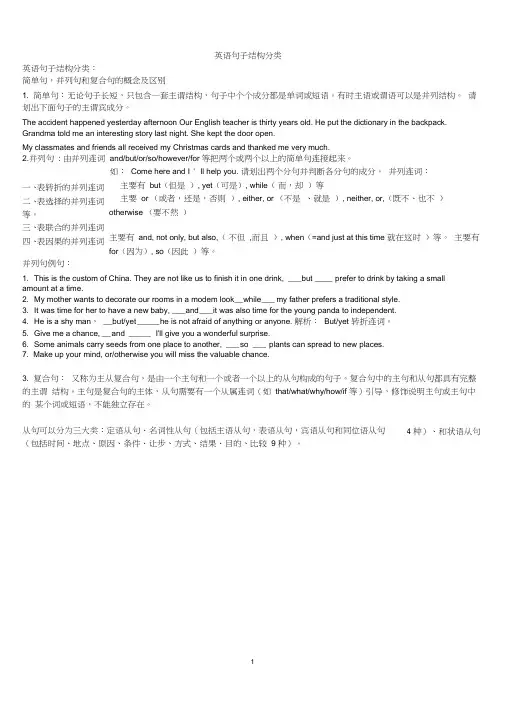
英语句子结构分类英语句子结构分类:简单句,并列句和复合句的概念及区别1. 简单句:无论句子长短,只包含一套主谓结构,句子中个个成分都是单词或短语。
有时主语或谓语可以是并列结构。
请划出下面句子的主谓宾成分。
The accident happened yesterday afternoon Our English teacher is thirty years old. He put the dictionary in the backpack.Grandma told me an interesting story last night. She kept the door open.My classmates and friends all received my Christmas cards and thanked me very much.and/but/or/so/however/for 等把两个或两个以上的简单句连接起来。
如: Come here and I ' ll help you. 请划出两个分句并判断各分句的成分。
并列连词:主要有 but (但是 ), yet (可是), while ( 而,却 )等 主要 or (或者,还是,否则 ), either, or (不是 、就是 ), neither, or,(既不、也不 ) otherwise (要不然 ) 主要有 and, not only, but also,( 不但 ,而且 ), when (=and just at this time 就在这时 )等。
主要有for (因为), so (因此 )等。
并列句例句:1. This is the custom of China. They are not like us to finish it in one drink, ___ b ut ____ prefer to drink by taking a smallamount at a time.2. My mother wants to decorate our rooms in a modem look__while ___ my father prefers a traditional style.3. It was time for her to have a new baby, ___and ___ i t was also time for the young panda to independent.4. He is a shy man , __but/yet _____ h e is not afraid of anything or anyone. 解析: But/yet 转折连词。
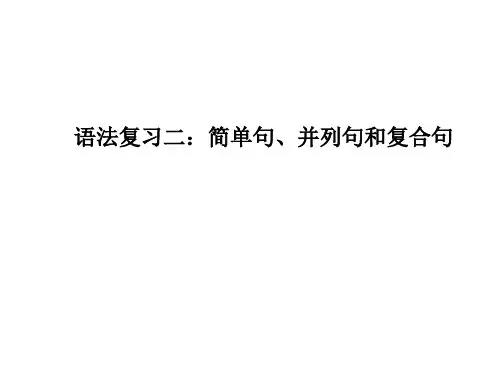
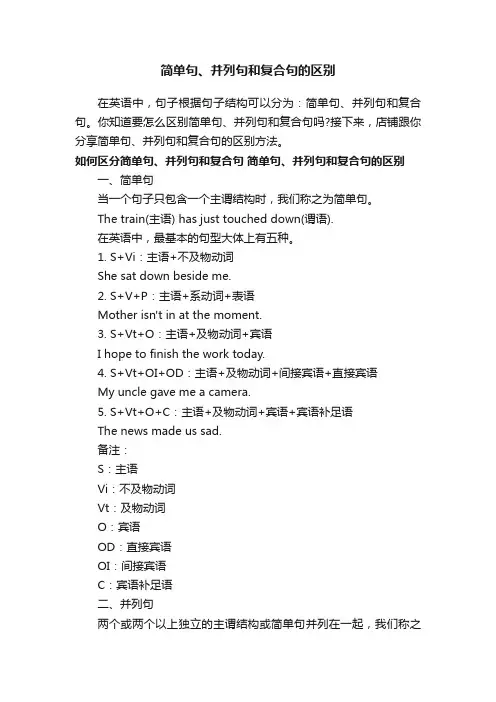
简单句、并列句和复合句的区别在英语中,句子根据句子结构可以分为:简单句、并列句和复合句。
你知道要怎么区别简单句、并列句和复合句吗?接下来,店铺跟你分享简单句、并列句和复合句的区别方法。
如何区分简单句、并列句和复合句简单句、并列句和复合句的区别一、简单句当一个句子只包含一个主谓结构时,我们称之为简单句。
The train(主语) has just touched down(谓语).在英语中,最基本的句型大体上有五种。
1. S+Vi:主语+不及物动词She sat down beside me.2. S+V+P:主语+系动词+表语Mother isn't in at the moment.3. S+Vt+O:主语+及物动词+宾语I hope to finish the work today.4. S+Vt+OI+OD:主语+及物动词+间接宾语+直接宾语My uncle gave me a camera.5. S+Vt+O+C:主语+及物动词+宾语+宾语补足语The news made us sad.备注:S:主语Vi:不及物动词Vt:及物动词O:宾语OD:直接宾语OI:间接宾语C:宾语补足语二、并列句两个或两个以上独立的主谓结构或简单句并列在一起,我们称之为并列句。
各个简单句间是平行并列的关系,而非从属关系。
并列句的各个分句间可用逗号、分号、起连接作用的副词或并列连接词来连接。
1. 能连接并列句的连词and(和,又),but(但是),for(因为),however(然而),or(或者),so(所以,因而),while(然而),yet(然而)2. 能连接并列句的复合连词or else(否则,要不然),either...or...(要么···,要么···;或者···,或者···),neither...nor...(既不···,也不···),not only...but also(不仅···,而且···)3. 能连接并列句的副词besides(而且,还有),hence(因此),otherwise(否则,要不然),then(然后,于是),therefore(因此,所以),thus(因而,从而) 根据并列分句之间的不同关系,并列句则可以分为以下四种。
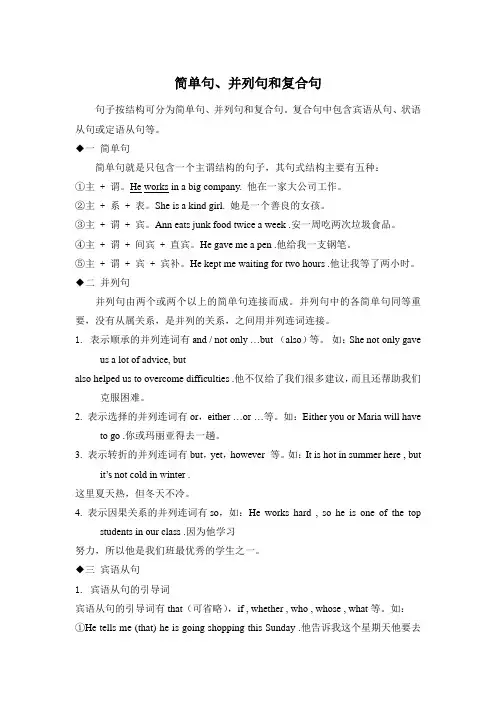
简单句、并列句和复合句句子按结构可分为简单句、并列句和复合句。
复合句中包含宾语从句、状语从句或定语从句等。
◆一简单句简单句就是只包含一个主谓结构的句子,其句式结构主要有五种:①主 + 谓。
He works in a big company. 他在一家大公司工作。
②主 + 系 + 表。
She is a kind girl. 她是一个善良的女孩。
③主 + 谓 + 宾。
Ann eats junk food twice a week .安一周吃两次垃圾食品。
④主 + 谓 + 间宾 + 直宾。
He gave me a pen .他给我一支钢笔。
⑤主 + 谓 + 宾 + 宾补。
He kept me waiting for two hours .他让我等了两小时。
◆二并列句并列句由两个或两个以上的简单句连接而成。
并列句中的各简单句同等重要,没有从属关系,是并列的关系,之间用并列连词连接。
1. 表示顺承的并列连词有and / not only …but (also)等。
如:She not only gaveus a lot of advice, butalso helped us to overcome difficulties .他不仅给了我们很多建议,而且还帮助我们克服困难。
2. 表示选择的并列连词有or,either …or …等。
如:Either you or Maria will haveto go .你或玛丽亚得去一趟。
3. 表示转折的并列连词有but,yet,however 等。
如:It is hot in summer here , butit’s not cold in winter .这里夏天热,但冬天不冷。
4. 表示因果关系的并列连词有so,如:He works hard , so he is one of the topstudents in our class .因为他学习努力,所以他是我们班最优秀的学生之一。
中考英语语法专项复习:简单句、并列句和复合句句子按结构可分为简单句、并列句和复合句。
复合句中包含宾语从句、状语从句或定语从句等。
◆一简单句简单句就是只包含一个主谓结构的句子,其句式结构主要有五种:①主 + 谓。
He works in a big company. 他在一家大公司工作。
②主 + 系 + 表。
She is a kind girl. 她是一个善良的女孩。
③主 + 谓 + 宾。
Ann eats junk food twice a week .安一周吃两次垃圾食品。
④主 + 谓 + 间宾 + 直宾。
He gave me a pen .他给我一支钢笔。
⑤主 + 谓 + 宾 + 宾补。
He kept me waiting for two hours .他让我等了两小时。
◆二并列句并列句由两个或两个以上的简单句连接而成。
并列句中的各简单句同等重要,没有从属关系,是并列的关系,之间用并列连词连接。
1. 表示顺承的并列连词有and / not only …but (also)等。
如:She not only gaveus a lot of advice, butalso helped us to overcome difficulties .他不仅给了我们很多建议,而且还帮助我们克服困难。
2. 表示选择的并列连词有or,either …or …等。
如:Either you or Maria will haveto go .你或玛丽亚得去一趟。
3. 表示转折的并列连词有but,yet,however 等。
如:It is hot in summer here , butit’s not cold in winter .这里夏天热,但冬天不冷。
4. 表示因果关系的并列连词有so,如:He works hard , so he is one of the topstudents in our class .因为他学习努力,所以他是我们班最优秀的学生之一。
名师手记之:英语篇(简单句、并列句和复合句)1.简单句、并列句和复合句① 句子种类两种分类法按照句子的用途,英语的句子可分:陈述句(肯定、否定)、疑问句(一般、特殊、选择、反意)、祈使句、感叹句等四种。
按照句子的结构可分:简单句并列句和复合句三种。
简单句只有一个主语或并列主语和一个谓语或并列谓语。
并列句由并列连词and, but, or,so等)或分号(;)把两个或两个以上的简单句连在一起构成。
复合句:含有一个或一个以上从句的句子。
复合句包含:状语从句\名词性从句(主语从句、宾语从句、表语从句和同位语从句)和定语从句等三种。
② 并列句的分类并列句指把两个同等重要的句子连接在一起,句子之间常用and, not only…but also…, neither…nor…, then等并列连词连接。
表示选择关系常用的连词有:or, either…or…, otherwise等表示转折关系常用的连词有:but, still, however, yet, while, when等。
表示因果关系常用的连词有:so, for, therefore等。
2.状语从句:(1)状语从句的分类状语从句通常修饰主句的动词或整个句子,由从属连词引导,从属连词在从句中不充当句子成分。
根据状语从句所表达的不同意义和功能,可分为时间、地点、原因、条件、目的、结果、让步、比较、方式等状语从句。
(2)连接状语从句的词语时间状语从句:when, whenever每当……,after, before, as, as soon as, hardly/ scarcely...when..., no sooner...than.。
.一……就……,while, till, until, since,once。
名词词组the first time第一次,last time最后一次,every/each time每次,the next time下次,the next day第二天, the moment, the minute, the second, the instant 一……就……;副词immediately, instantly, directly等也可作连词使用。
句子成分什么是句子?句子的定义:句子是包含主语和谓语部分的一组词。
句子的成分:句子由各个组成部分构成,这些组成部分叫做句子的成分。
句子的成分可分为:主语、谓语、表语、宾语、同位语、定语、状语、补语、独立成分等。
句子按其结构可分为:简单句、并列句、复合句、并列复合句。
句子结构一、简单句(Simple sentence)的构成:1.主语+系动词+表语(Subject+Linking verb+Predicative )1) He │was │a student.2) The dinner │smells │good.3) The trouble│is │that they are short of money.2. 主语+谓语(Subject+V erb)1) The moon │rose.2) We all │breathe, eat, and drink.注意:此句型的句子有一个共同特点,即句子的谓语动词都能表达完整的意思。
此种类型句子中谓语动词一般为不及物动词。
3.主语+谓语+宾语(S+V+Object)1) He │enjoys │reading.2) He │has refused │to help them.注意:此句型句子谓语动词都具有实义,都是主语产生的动作,但不能表达完整的意思,必须跟有一个宾语,即动作的承受者,才能使意思完整。
这类动词叫做及物动词。
4. 主语+谓语+双宾语(S+V+O+O)1) He │brought │you │a dictionary.=He │brought │a dictionary │for│you.2) He │showed │me │how to run the machine.注意:有些及物动词可以有两个宾语,这两个宾语通常一个指人,为间接宾语;一个指物,为直接宾语。
一般的顺序为:动词+ 间接宾语+ 直接宾语。
如:Give me a cup of tea, please. 或动词+ 直接宾语+介词+ 间接宾语。
中考英语语法专项复习:简单句、并列句和复合句句子按结构可分为简单句、并列句和复合句。
复合句中包含宾语从句、状语从句或定语从句等。
◆一简单句简单句就是只包含一个主谓结构的句子,其句式结构主要有五种:①主 + 谓。
He works in a big company. 他在一家大公司工作。
②主 + 系 + 表。
She is a kind girl. 她是一个善良的女孩。
③主 + 谓 + 宾。
Ann eats junk food twice a week .安一周吃两次垃圾食品。
④主 + 谓 + 间宾 + 直宾。
He gave me a pen .他给我一支钢笔。
⑤主 + 谓 + 宾 + 宾补。
He kept me waiting for two hours .他让我等了两小时。
◆二并列句并列句由两个或两个以上的简单句连接而成。
并列句中的各简单句同等重要,没有从属关系,是并列的关系,之间用并列连词连接。
1. 表示顺承的并列连词有and / not only …but (also)等。
如:She not only gaveus a lot of advice, butalso helped us to overcome difficulties .他不仅给了我们很多建议,而且还帮助我们克服困难。
2. 表示选择的并列连词有or,either …or …等。
如:Either you or Maria will haveto go .你或玛丽亚得去一趟。
3. 表示转折的并列连词有but,yet,however 等。
如:It is hot in summer here , butit’s not cold in winter .这里夏天热,但冬天不冷。
4. 表示因果关系的并列连词有so,如:He works hard , so he is one of the topstudents in our class .因为他学习努力,所以他是我们班最优秀的学生之一。
二、简单句、并列句和复合句(一)句子种类两种分类法1、按句子的用途可分四种:1)陈述句(肯定、否定):He is six years old; She didn't hear of you before.2)疑问句(一般、特殊、选择、反意):Do they like skating? How old is he? Is he six or seven years old? Mary can swim, can't she?3)祈使句:Be careful, boys; Don't talk in class4)感叹句:How clever the boy is!2、按句子的结构可分三种:1)简单句:只有一个主语(或并列主语)和一个谓语(或并列谓语)。
e.g. He often reads English in the morning.Tom and Mike are American boys.She likes drawing and often draws pictures for the wall newspapers.2)并列句:由并列连词(and, but, or等)或分号(;)把两个或两个以上的简单句连在一起构成。
e.g. You help him and he helps you.The future is bright; the road is tortuous.前途是光明的,道路是曲折的。
3)复合句:含有一个或一个以上从句的句子。
复合句包含:名词性从句(主语从句、宾语从句、表语从句和同位语从句)、定语从句和状语从句等。
e.g. The foreign visitors took a lot of pictures when they were at the Great Wall.(二)简单句的五种基本句型1、主语+ 系动词+表语:e.g. He is a student.2、主语+不及物动词:e.g. We work.3、主语 +及物动词 +宾语:e.g. Henry bought a dictionary.4、主语+及物动词+双宾语(间接宾语+直接宾语):e.g. My father bought me a car.5、主语+及物动词+复合宾语(宾语+宾补):e.g. Tom made the baby laugh.注:其他各种句子都可由这一种基本句型扩展、变化或省略而构成。
简单句并列句复合句并列复合句Revised final draft November 26, 2020简单句、并列句、复合句、并列复合句文章来源:在前面各讲中所说的肯定句、否定句、各种疑问句、感叹句等,是根据句子的作用来划分的。
今天,我们再学习一种新的分类方法:即根据句子的内部结构,特别是句子与句子之间的关系来划分的方法。
根据句子结构,可以分为三种主要类型:简单句、并列句、复合句,另外还有一种叫并列-复合句子。
要搞懂英语句子结构分类,有一点首先必须明白:即什么是“句子”句子的概念有两层含义:一是它能表达一个清晰、完整的意思。
反过来讲,只要能表达一个清晰、完整的意思的语言单位,不论是长是短,哪怕是一个单词,也算作是一个句子。
这是从意义方面来说的。
二是句子的结构完整。
所谓“完整”,最核心的是一个句子应该有“主语、谓语”。
也就是说,有主语、有谓语的语言单位就是一个句子。
这就是从句子结构方面来分的,也是从句子语法成份方面来划分的。
我们所讲的简单句、并列句、复合句都是从主语、谓语来判定句子类型的。
如果按照句子的结构分类,英文句子可分为三种类型:简单句(Simple Sentence),并列句(Compound Sentence)和复合句(Complex Sentence)。
一、简单句简单句的定义是:或者只有一个主语,或者只有一个谓语。
为什么说“或者”呢因为简单句可以只有一个主语,但有几个谓语;或者可以有几个主语,但只有一个谓语。
这样一分,简单句就有三种形式了。
1、只有一个主语、一个谓语,再加上其它成份。
例如:Light travels faster than sound.光比声传播速度快。
The film is not interesting.这部电影没有意思。
Can you finish the work on time 你能按时完成工作吗 2、只有一个主语,但有几个谓语,再加上其它成份。
例如: The boy were running, shouting and laughing. 男孩们一边跑,一边笑,一边喊叫着。